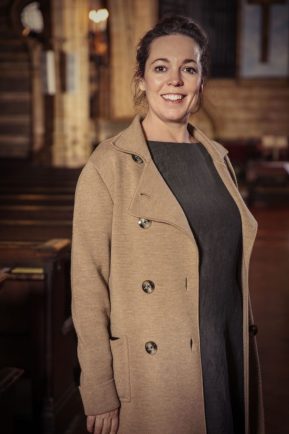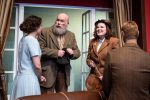HIT BBC show Who Do you Think You Are? returned to our screens this week featuring actress Olivia Colman.
The programme is available on the iPlayer at www.bbc.co.uk/iplayer and The Standard’s Neil Gordon took a look at the programme in detail.
BROADCHURCH ACTRESS Olivia Colman is the latest celebrity to have their family heritage investigated under the spotlight of Who Do You Think you Are?
With three BAFTA awards and a Golden Globe to her name, Colman has established herself as a versatile performer in drama and comedy, across both television and film, during an impressive career encompassing The Accused (2010-2012), Hot Fuzz (2007) Iron Lady (2011), Dr Who (2010) and the Peep Show (2003-2015).
Now taking a peep into her own family background, the 44 year-old grew up in Norwich and knows that her dad’s family goes back generations there.
However, she knows far less about her mum’s side. Her mum once said there was a French woman among their ancestors, although she knows nothing more than that.
“For me it’s very exciting that there’s someone who’s not from Norfolk.”
Olivia lives in London with her husband and children.
“I’m interested in …well, in the people that have gone before. There’s a fragility to life. And also, when you go…will you be forgotten? I don’t know what’s happened in my family, I don’t know who’s been forgotten. And it might be quite nice to remember them again.”
“If there’s any adventurers in my family…they’d be so disappointed. Because I think I’m currently probably the least adventurous person I know.”
Olivia heads to Norfolk to see her parents, who still live there.
“I feel like it’s in my bones and blood, being here.”
Olivia’s father agrees that his side of the family is Norfolk to the core. But on her mother’s side, Olivia’s uncle Richard has done some research and created a family tree that goes back to 1766 and Olivia’s 4 x great grandparents Richard Campbell Bazett and Sarah Bazett. Richard Campbell Bazett was born on the Island of St. Helena in the South Atlantic, and later worked in London for the East India Company.
“But that’s so exotic, isn’t it? St. Helena, East India Company…isn’t it weird that you end up just not knowing?”
Olivia returns to London, where her 4 x great grandfather Richard Campbell Bazett was working in the early 1800s, to meet Historian Rebecca Probert. From Richard’s account book, Olivia sees that in his work with the East India Company he was dealing with large sums of money. He spent time both in London and in Calcutta (as Kolkata was then called). Olivia sees that he had married a woman called Margaret Ann Hampton.
“What? I thought she was Sarah? Who’s Margaret? I thought he was married to Sarah.”
Rebecca explains that Margaret was Richard’s first wife – before he married Olivia’s 4 x great grandmother Sarah. A church court manuscript records the case of Bazett v. Bazett – not a divorce case, but a petition for separation.
Olivia discovers that Richard accused Margaret of having an affair with a harpist she met at her sister’s house by the name of Frederick Dizi.
As a result, Richard was granted a legal separation from Margaret, but with a clause that neither party would be allowed to remarry. To remarry, Richard would have to be granted a divorce – a complicated and expensive process at this time, which required an act of parliament.
Olivia heads to the parliamentary archives at Westminster to find out if Richard petitioned for a divorce and is met there by family law expert Joanne Begiato. They find the original act of parliament which shows that Richard did indeed successfully appeal for and obtain a divorce on the basis of Margaret’s ‘open adultery’ in 1809, and that within this act there was a clause included to allow for remarriage.
“So hopefully he now goes on to find Sarah?”
From Richard’s will, Olivia learns that not only did Sarah and Richard marry, but they went on to have five sons together – one of whom was Olivia’s great-great-great grandfather Charles Young Bazett. Joanne then shows Olivia Charles’ cadet papers which show he was a member of the army. On the record, it states the year of his birth is 1807.
“1807? Hang on a minute?… No!”
Olivia realises Richard was having children with Sarah before being granted the divorce from his first wife Margaret. Their eldest child William was baptised in the summer of 1806, the summer before Margaret was accused of being unfaithful with Frederick Dizi.
“I liked him a little while ago but now… what a hypocrite.”
Olivia now turns her attention to Richard’s son, her 3x great grandfather Charles Young Bazett. In the 1871 census she find an older Charles living in Reading with his wife: Harriot. He is a retired Lieutenant Colonel of the Indian Army and they seem to be living a comfortable life of retirement. Under Harriot’s place of birth, Olivia notices she is born in Kishanganj – a remote town in the north east of India and her next port of call.
“I’m not very brave – I don’t go anywhere…Norfolk, that’s it!”
Olivia travels to Kishanganj in north east India to find out more about her three times great grandmother Harriot.
“The thought that members of my family have lived here is amazing. It’s such a long way to come!”
Olivia goes to the former British club in Kishanganj to meet historian Anuradha Chatterji. From Harriot’s marriage certificate Olivia discovers that her maiden name was Slessor and that her father was (Olivia’s 4 x great grandfather) William Slessor. They find William Slessor was an active member of the East India Company army, becoming a captain in 1804 and travelling widely. However, despite his daughter Harriot being born in Kishanganj, there is no sign of a marriage record for William or indeed a birth certificate for Harriot. The strong possibility therefore, is that Harriot’s mother wasn’t British…but a local woman. It would have been very unusual for a British woman to be living so far into the interior of India at this time. This, combined with the lack of records for Harriot’s mother and a marriage for her father mean it’s probable Olivia’s 4 x great grandmother was a local Indian woman.
“Oh this is so exciting! I’m so much more interesting than I thought I was!”
Olivia finds out more about William’s life in Kishanganj through an administrative list of his possessions. Olivia finds everything ranging from ink powder, to a Hooka pipe, to pantaloons, to an actual elephant!
But Olivia then discovers an article from 1810 showing a tragic accident befell Harriot’s father William. Whilst out shooting, William’s gun misfired and shot him straight through the head killing him instantly. Harriot would only have been around three years old at the time. There is no clue as to what may have happened to Harriot’s mother, but there is a letter from a lawyer which shows that Harriot’s grandmother, also named Harriot, paid for a voyage to bring her little granddaughter to England.
“She’s so little… Going to the other side of the world. Wondering where daddy has gone…and without mummy.”
Olivia learns that to get to England, Harriot would first have to travel 500km to Calcutta as the city was then know.
Olivia follows Harriot’s path to (now) Kolkata to find out more about Harriot’s journey to England. On the banks of the Hooghley river Olivia meets Dr Sudip Bhattacharya. A record of the ship Harriot travelled on shows Harriot travelled all alone on a journey that would have taken 6 months.
“This little person… Without her, I wouldn’t be here. I feel quite invested in finding out about what happened to her.”
Olivia meets Professor Rudrangshu Muckherjee who has more information. They find the first mention of Harriot in England in the will of a woman named Louise Girardot in 1824 – Harriot’s great aunt. Louise leaves Harriot £300 indicating that she did go on to become a part of the family. Louise then bequeaths an additional £500 to Harriot four years later.
“Oh her luck has changed… She’s about 21 now and has her own money.”
Using the money Harriot then invests part of her fortune into coming back to Calcutta, the possibility being that she was searching for her mother, her roots, or maybe even a husband? This is a turning point in her life. In 1832, they find she married a man named William Trigge Garrett.
“I thought my great-great-great grandfather was Charles Bazett?”
It transpires that William was Harriot’s first husband. They met on the very ship she travelled to Calcutta on but unfortunately after only a year of marriage, William died aged 29.
Olivia comes to St John’s Church in Calcutta to meet Professor Rochana Chakraborty to see if she can find out what happened to Harriot next. Rochana shows her a letter written by Olivia’s three times great grandfather, Charles Young Bazett, to his brother Richard. In it, he writes of how he first met Harriot in India and fell in love with her there but that Harriot turned him down. Four years later, they met again in England at the house of the brother of her first husband, William Trigge Garret. With affection, Charles notes every detail of their courtship and how Harriot eventually returned his feelings.
I love it that he’s telling his brother everything! “I took her hand again and allowed mine to remain touching it for some time…and I did fancy that once or twice there was a little motion which might have said ‘I am not indifferent to you.’”
Rochana tells Olivia that they went on to marry and shows Olivia a photograph of the couple, much to Olivia’s excitement.
Rochana and Olivia board a boat up river in Kolkata and read another letter from Charles to his brother in 1839, in which he describes how Harriot is pregnant with their child. At the end of the letter, Harriot herself even writes a few lines. They find the baby was delivered safely as well as three more children, all of whom were born in India.
“She’d been on her own all this time and now she’s found someone she loves who loves her back, a big family, lots of children… What an amazing life Harriot ended up having.”
Olivia wonders more about the woman who made this all possible; Harriot’s grandmother (and Olivia’s 5 x great grandmother), Harriot Elizabeth Slessor. Olivia is given her will and sees that Harriot affectionately referred to her granddaughter ‘India Harriot’, showing that the India connection was always noted. Olivia sees a book on the Slessor family based on original documents belonging to some distant descendants of the family in Scotland. Olivia resolves to go there to find out more…
“I was very surprised at how much I ended up caring for her (Harriot)…to find out that her mum was local was the most exciting…When I realise it’s tangible – her grandson is my mum’s grandad, which means we’ve all touched each other’s hands throughout time…that really brings it home that she was real.”
Olivia travels to the Scottish Highlands to meet Geordie Burnett – another present day descendant of Harriot Elizabeth Slessor. Harriot Elizabeth lived in Portugal for most of her life where her husband was stationed in the army. Geordie has a portrait of her, as well as a series of her diaries and letters from the late 18th century.
Olivia reads through passages which describe her 5 times great grandmother Harriot Elizabeth’s deep love and devotion to her children, as well as the close ties within the family. (There even includes a mention of Harriot Elizabeth’s sister, Louise Girardot; the very same Louise who Olivia remembers went on to leave a fortune to India Harriot, and who it seems also took an active role in taking care of her nieces and nephews.) Harriot Elizabeth recounts various sad partings in the letters.
“You always assume that people were told to ‘pull yourself together…chin up…stiff upper lip’, but it’s so nice to see…they obviously suffered the same pain as we did and they didn’t always keep their mouths shut.”
Olivia continues reading and finds a heartfelt description of Harriot Elizabeth’s goodbye to her own mother, at which point Geordie shows Olivia a series of portraits of his ancestors including one at the top of the stairs of this very woman: Harriot Elizabeth’s mother – Anne Judith Bristow. She sits on the wall next to a portrait of her husband John Bristow, who as it happens was the MP for Olivia’s home county of Norfolk.
Geordie then reveals that Olivia’s 6 times great grandmother Anne was not in fact British by birth, and presents Olivia with her naturalisation document. It shows that Anne was born in Paris to a man named Paul Foissin. It appears that she and her family were French Huguenots and, like many others at this time, had come over to England as refugees.
“French! She’s the French woman! Oh my God.”











